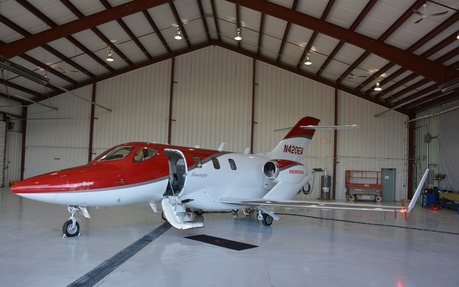HondaJet is the luxury marvel of aviation
Honda has never been just about cars. For over 68 years, the Japanese brand has one of the most diversified portfolios in the industry. Long before Honda founder Soichiro Honda started manufacturing cars, he ruled the roost as the world's largest motorcycle manufacturer—a title the company still holds today. It wasn't until the early '60s that Honda produced its first car, and another 10 years until the Civic landed on North American soil. Along the way, Honda was the first to create its own luxury brand in Acura; followed by some dabbling in ATVs, lawnmowers, and even its own robot named Asimo.
Honda isn't new to innovation, but when I received the invite to check out the Honda HA-420 HondaJet at the Buttonville Municipal Airport, just north of Toronto, even I was surprised. However, I wasn't sure what surprised me the most; the fact that I never heard of the HondaJet—a company that was founded in 2006 by designer and engineer Michimasa Fujino, a former vice president at Honda R&D Americas—or that it was a state-of-the-art business jet that starts at USD$4.85 million?
- Also: The HondaJet Will be Available in 2015
- Also: 2017 Honda Accord Hybrid is more powerful, fuel efficient
Honda has long been renowned for its solid reputation for reliability, safety and comfort in a reasonably priced package. And here I was staring at a modernized marvel of an advanced lightweight jet that has set the bar so high for an industry that has its fair share of older products.
The Honda Aircraft Company, based out of Greensboro, North Carolina may be making waves within the aviation industry, but the dream of President and CEO Fujino started with some sketches in the early '90s on the back of a calendar with a final one that would eventually get patented in 1997. At that time, he was studying aviation, which eventually led him to modify a small older plane, while all along testing technology and his own theories.
The HondaJet is actually his third attempt at a jet, but this one definitely stuck and as of December 2015, it's been certified by the FAA with a target to receive its Canadian certification in the first quarter of 2017.

Beyond its cost and amenities, the HondaJet separates itself from the competition by flying higher (with a maximum cruising altitude of 43 000 ft.), faster (with a maximum cruising speed of 420 knots or 777 km/h) and more fuel efficiently with a range of 1223 Nautical miles (2264 km). It's the only jet to have an over the wing engine mount, and when combined with a natural laminar flow design for the wing and its curvy carbon fibre fuselage, the HondaJet is able to reduce drag at high speeds, as well as provide a smooth and quiet drive with less vibration.
As good as that sounds, the construction of the single-pilot jet is twofold. It not only betters its ride in every way, the unique design enables more cabin and baggage space. In total, there are seven seats: four passenger spots facing each other, another across from the door (typically for a flight attendant) and two in the cockpit. In the back of the jet, you'll find a large washroom area that has its own lavish sink with a motion sensor and vanity.
As I entered the HondaJet, its tight confines were quickly realized. Headroom is hard to come by, but once you sit down, you gain an appreciation for how resourceful Honda was with such little space. Its passenger seats have an automatic sliding feature that can shift you forward, back, or to the side. It's a type of swivel feature that provides you and the passenger directly seated in front of you ample legroom and personal space to relax or do work. In addition, there's a fold out arm bar, a table and multiple cupholders when needed.<

There are many Honda touches in this jet that include carbon fibre composites, reduction of drag coefficients and the automated reclining seat functions, but none bigger than Honda's own bread and butter—the engine. Honda's partner in developing the engine is GE and together the group has developed two GE Honda Aero HF120 turbofan engines that produce 1997 pounds of thrust. We didn't get to see how it sounds or flies, but we're hoping that will be in the follow-up.
With a lack of new jets coming to market, Honda is in the perfect situation to appeal to elite businesses and small fleet operators. It comes at a steep cost that ranges from USD$4.85 to 5.2 million, but with 100 global orders already placed, it would appear that consumers are taking notice.
Without Honda's resources of capital, research and development, and patience—Fujino's dreams of the HondaJet wouldn't have come to fruition. From a simple sketch to the height of the aviation industry is an incredible accomplishment, especially when you consider that Honda has other priorities in the auto and motorcycle industry.
The transfer of technology from the auto world to aviation has definitely played a part in making this business jet faster, more comfortable and more fuel efficient. If Honda continues to back its Honda Aircraft Company with resources, the sky's the limit for this HondaJet marvel.
